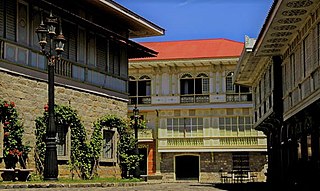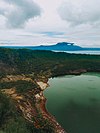
Laguna, officially the Province of Laguna, is a province in the Philippines located in the Calabarzon region in Luzon. Its capital is Santa Cruz while its largest city is the City of Calamba and the province is situated southeast of Metro Manila, south of the province of Rizal, west of Quezon, north of Batangas and east of Cavite. Laguna hugs the southern shores of Laguna de Bay, the largest lake in the country. As of the 2020 census, the province's total population is 3,382,193. It is the seventh richest province in the country.

The Pasig River is a water body in the Philippines that connects Laguna de Bay to Manila Bay. Stretching for 25.2 kilometers (15.7 mi), it bisects the Philippine capital of Manila and its surrounding urban area into northern and southern halves. Its major tributaries are the Marikina River and San Juan River. The total drainage basin of the Pasig River, including the basin of Laguna de Bay, covers 4,678 square kilometers (1,806 sq mi).

San Pablo, officially the City of San Pablo, is a 1st class component city in the province of Laguna, Philippines. According to the 2020 census, it has a population of 285,348 people.

Calamba, officially the City of Calamba, is a 1st class component city in the province of Laguna, Philippines. According to the 2020 census, it has a population of 539,671 people.

Santa Rosa, officially the City of Santa Rosa, is a 1st class component city in the province of Laguna, Philippines. According to the 2020 census, its population was 414,812 people.

Pila, officially the Municipality of Pila, is a 3rd class municipality in the province of Laguna, Philippines. According to the 2020 census, it has a population of 54,613 people.

Juan Cailles y Kauppama was a Filipino general and politician. A member of the revolutionary movement Katipunan, he was a commanding officer of the Philippine Revolutionary Army who served during the Philippine Revolution and Philippine–American War. He later served as a provincial governor of Laguna and a representative from Mountain Province.

Santa Rosa, officially the Municipality of Santa Rosa is a 1st class municipality in the province of Nueva Ecija, Philippines. According to the 2020 census, it has a population of 75,649 people.

The architecture of the Philippines reflects the historical and cultural traditions in the country. Most prominent historic structures in the archipelago are influenced by Austronesian, American architectures.

Ancestral houses of the Philippines or Heritage Houses are homes owned and preserved by the same family for several generations as part of the Filipino family culture. It corresponds to long tradition by Filipino people of giving reverence for ancestors and elders. Houses could be a simple house to a mansion. The most common ones are the "Bahay na Bato". Some houses of prominent families had become points of interest or museums in their community because of its cultural, architectural or historical significance. These houses that are deemed of significant importance to the Filipino culture are declared Heritage House by the National Historical Commission of the Philippines (NHCP), previously known as the National Historical Institute (NHI) of the Philippines. Preservation is of utmost importance as some ancestral houses have come into danger due to business people who buy old houses in the provinces, dismantle them then sell the parts as ancestral building materials for homeowners wishing to have the ancestral ambiance on their houses. These ancestral houses provide the current generation a look back of the country's colonial past through these old houses.

The Rizal Monument in Calamba is a monument built to commemorate the sesquicentennial (150th) birth anniversary of Dr. José Rizal, the Philippines' unofficial national hero and the greatest son of Calamba. It is a 6.7 metres (22 ft) statue sculpted by Jonas Roces and is located at The Plaza, a 6.7-hectare (17-acre) park in front of the Calamba City Hall Complex along Bacnotan Road in the barangay of Real. President Benigno Aquino III led the unveiling of the monument on June 19, 2011. The monument was cited as the tallest Rizal monument in the world before former Laguna Governor Jeorge 'E.R.' Ejercito Estregan inaugurated a 26 feet bronze Rizal Monument sculpted by Toym Imao, son of National Artist for Sculpture Abdulmari Asia Imao in Santa Cruz, Laguna, for the 2014 Palarong Pambansa hosted by the province.

The Nagcarlan Underground Cemetery (Filipino: Libingan sa Ilalim ng Lupa ng Nagcarlan) is a national historical landmark and museum in Barangay Bambang, Nagcarlan, Laguna supervised by the National Historical Commission of the Philippines. It was built in 1845 under the supervision of Franciscan priest, Fr. Vicente Velloc as a public burial site and its underground crypt exclusively for Spanish friars, prominent town citizens and members of elite Catholic families. It is dubbed as the only underground cemetery in the country.

Cuartel de Santo Domingo, also known as Fort Sto. Domingo and Intramuros of Sta. Rosa, is an old two-storey Spanish barracks building in Santa Rosa, Laguna in the Philippines. It is currently used as the headquarters of the Special Action Force of the Philippine National Police.
This is a list of historic houses in Santa Ana, Manila, the Philippines.

Ronald Marapon dela Rosa, also known as Bato, is a Filipino politician and retired police officer who is currently serving as a senator of the Philippines since 2019. He served under the Duterte administration as the chief of the Philippine National Police from July 1, 2016, to April 19, 2018, overseeing the government's anti-drug campaign; he also served as the Director General of the Bureau of Corrections from April 30 to October 12, 2018.

SM City Santa Rosa is a large shopping mall owned and operated by SM Prime Holdings. It is located along Old National Highway, Barangay Tagapo, Santa Rosa, Laguna, Philippines. Opened in 2006, it is the first SM Supermall in the province of Laguna.
Landmark is a Filipino department store and supermarket chain run by Citysuper Incorporated, the holding company of the Landmark Corporation, owned by Enrique Cheng. It currently has multiple operational department stores and supermarkets across Metro Manila and one provincial branch located in Santa Rosa, Laguna.

Arcovia City is a mixed-use development in Ugong, Pasig, Metro Manila, the Philippines. It is a 12.3-hectare (30-acre) riverside township located by the Marikina River east of Ortigas Center being developed by the Megaworld Corporation.
Pedro Siochi was a Philippine architect and civil engineer of famous landmarks in the Philippines.




















